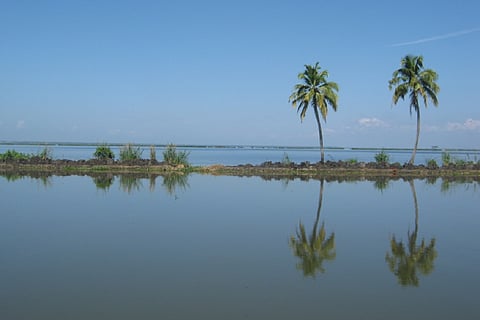

A day before World Environment Day, KN Balagopal, Kerala’s Finance Minister, read out the motto for this year – ecosystem restoration – in his Budget presentation on June 4. In a quick one-hour speech, he dedicated a few paragraphs of the Budget plan for the environment, most of which circle the water bodies of Kerala. He announced an amount of Rs 50 crore for the first phase of a comprehensive project for environmental restoration, with an estimated expenditure of Rs 500 crore.
Mentioning the heavy rainfall and floods in recent years, Minister Balagopal spoke of the amount of silt, clay, sand and waste deposited in rivers and dams, leading to a reduction in storage capacity and obstruction in the flow of rivers. The change of course of rivers results in floods in populated areas, he said. The dumping of waste also causes water pollution and diseases and depletion of fish, he said.
The minister also mentioned that some recommendations of the Post Disaster Need Assessment (PDNA) report published after the 2018 flood would be followed. The report recommended adopting such measures as ‘room for river’, ‘living with water’ and ‘eco-friendly construction’.
Advocate and environmentalist Harish Vasudevan told TNM that this is a good sign. "Warm welcome for this proposal. It is good that at least one suggestion of the PDNA report is now taken into consideration by the government."
But, he added, "Some among these are civil contract works and definitely, government departments and contractors will be interested to do those alone. But what about stopping the waste dumping into water bodies? How many cases have been registered and what action plan is suggested to avoid future dumping? How can we strengthen the department as such by starting district wise centres for monitoring? The Environment Directorate is the only one having no officer or office in the district level. We are not able to achieve the target of earlier projects announced. I hope this time, there will be a change."
KN Balagopal read from the Budget document on Friday: "Floods could be contained to a great extent through augmenting and improving water carrying capacity of various water bodies and river basin systems. I am happy to declare a comprehensive package for this."
However, there is no long term vision, Harish said. "There was no money allocated for climate change mitigation goals, no proposal to identify disaster prone areas in the land use plan as suggested by the PDNA," he explained.
However, the 2021-22 Budget was only a revision of the one presented by former Finance Minister Thomas Isaac in January, which elaborates a comprehensive environmental approach. Along with the plans for water bodies are those for expanding green cover, biodiversity, the e-vehicle policy, forest conservation, separate proposals for flood-affected Kuttanad, farmers in Wayanad and Idukki and another package for Kasargod. Harish said that he could not see any efforts to fulfill the PDNA recommendations in the earlier version too.
Ushakumari S of Thanal, an environmental NGO, says that though the new budget mentions all the issues, there is no clarity on the methods to be used to resolve them. "I also feel the initial allocation of Rs 50 crore and then going up to Rs 500 crore would not be enough to protect or restore the rivers, since the Budget mostly talks about protecting water bodies. Rivers originating from the Western Ghats are mostly all degraded, with dams and pollution and the natural vegetation all gone. We are talking about a decade of eco restoration, it should be done closely with the people."
Some of the methods that Balagopal's Budget mentions are protecting and cleaning the banks of canals, deepening (of rivers) through de-silting, removal of sand deposited in dams, reservoirs and rivers, construction of mangrove barriers along coastal areas, strengthening or raising of higher portions of land and bunds, shifting of bunds and dykes to outlying areas and so on. "Water resources, Environment and Local Self Government Departments will collectively implement this comprehensive project," he said.